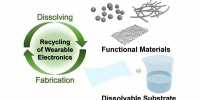Researchers have demonstrated “giant flexoelectricity” in soft elastomers, which could extend the range of robot movement and make self-powered pacemakers a reality. Scientists from the University of Houston and the Air Force Research Laboratory explain how to turn seemingly ordinary substances like silicone rubber into electric powerhouses in a paper published this month in the Proceedings of the National Academy of Sciences.
What do a self-powered implanted medical device, a soft human-like robot, and how do we hear sound have in common? The answer to why these two disparate technologies and biological phenomena are similar lies in how the materials they are made of, like a rubber band, can significantly change in size and shape when an electrical signal is sent.
Some natural materials can perform this function by acting as an energy converter, deforming when an electrical signal is passed through or supplying electricity when manipulated. This is known as piezoelectricity, and it can be used to make sensors and laser electronics, among other things. However, these naturally occurring materials are rare, have stiff crystalline structures, and are frequently toxic, all of which are significant drawbacks for human applications.
Researchers have demonstrated ‘giant flexoelectricity’ in soft elastomers that could improve robot movement range and make self-powered pacemakers a real possibility.
Human-made polymers help to alleviate these pain points by eliminating material scarcity and creating soft polymers capable of bending and stretching, known as soft elastomers; however, soft elastomers previously lacked significant piezoelectric properties.
Kosar Mozaffari, a graduate student at the Cullen College of Engineering at the University of Houston; Pradeep Sharma, M.D. Anderson Chair Professor & Department Chair of Mechanical Engineering at the University of Houston; and Matthew Grasinger, LUCI Postdoctoral Fellow at the Air Force Research Laboratory offer their findings in a paper published this month in the Proceedings of the National Academy of Sciences.
“This theory creates a link between electricity and mechanical motion in soft rubber-like materials,” Sharma explained. “While some polymers are weakly piezoelectric, there are no truly soft rubber-like piezoelectric materials.”

The term “giant flexoelectricity” refers to these multifunctional soft elastomers with increased capability. In other words, these researchers show how to improve flexoelectric performance in soft materials.
“Flexoelectricity in most soft rubber materials is quite weak,” said Mozaffari, “but our theory shows that soft elastomers can attain a greater flexoelectricity of nearly 10 times the conventional amount by rearranging the chains in unit cells on a molecular level.”
The applications are numerous. Human-like robots made of soft elastomers with enhanced flexoelectric properties would have a greater range of motion for performing physical tasks. Pacemakers implanted in human hearts and powered by lithium batteries could be self-powered because natural movement generates electrical power.
The mechanics of soft elastomers generating and being manipulated by electrical signals mimics a function seen in human ears. Sounds are received by the eardrum, which vibrates and sends electrical signals to the brain, which interprets them. Movement in this case can manipulate soft elastomers and generate enough electricity to power a device on its own. This method of self-generating power through movement appears to be a step up from a standard battery.
The advantages of this new theory go beyond that. The ability to design a unit cell that is stretch invariant – or remains unchanged under unwanted stretch transformation – emerged during the research process.
“For some applications, we require specific amounts of electricity to be generated regardless of stretch deformation, whereas, for others, we desire as much electricity generation as possible, and we have designed for both of these cases,” Mozaffari explained.
“We discovered a method to make one unit cell stretch invariant during our research. The tunable nature of the flexoelectric direction has the potential to be useful in the development of soft robots and soft sensors.”
In other words, the amount of electric power generated by various forms of physical stimulation can be controlled in order for devices to perform specific actions. This can help to moderate the operation of self-contained electronic devices.
The theory will then be tested in a lab using potential applications. Furthermore, efforts to improve the flexoelectric effect in soft elastomers will be the focus of future research.















